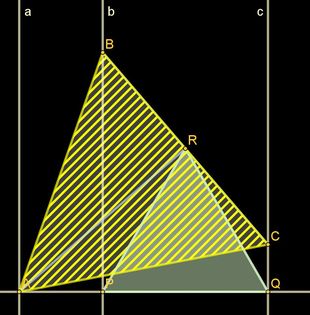Find the Side
Another cute geometry puzzle was posted on Facebook.
Puzzle. An equilateral triangle in a plane has three vertices with known x-coordinates: a, b, and c. What is the side of the triangle?
I want to describe three different solutions that the readers of the Facebook channel posted. But before doing so, let’s look at the problem’s symmetries. We can immediately say that the answer should be a symmetric function of three variables: |a-b|, |b-c|, and |c-a|. It is possible to coordinate-bash the problem. However, I always prefer geometric solutions. Having said that, if one wants a calculation, using complex numbers might speed things up.
A solution using complex numbers. Suppose c is the origin, then the first vertex corresponds to a complex number a+xi. Then, the second vertex can be found after rotating the first vertex around the origin by 60 degrees. That means it is at (a+xi)exp(±2πi/6). Without loss of generality, we can assume that the second vertex corresponds to (a+xi)(1+i√3)/2. It follows that b = (a−x√3)/2. Thus, x = 2(a/2-b)/√3. And the side length is √(a2+x2) = √(4(a2-ab+b2)/3). Adjusting for the choice of the origin, we get that the length is √(2((a-b)2+(b-c)2+(c-a)2)/3).
A geometric solution. Draw a line through point A parallel to the x-axis. Denote the intersections of this line with lines x=b and x=c as P and Q, correspondingly. Let R be the midpoint of the side BC. Then, the triangle PQR is equilateral. To prove it, notice that angles ARC and AQC are right, which implies that points ARCB are on the same circle with diameter AC. It follows that the angles RCA and RQA are the same; thus, the angle RQA is 60 degrees. Given that the triangle PQR is isosceles as R has to be on the bisector of PQ, we conclude that the triangle PQR is equilateral. Now, we can calculate the height of PQR and, therefore, the height of ABC, from which the result follows.

A physics solution. Without loss of generality, we can assume that a+b+c=0. Thus, the y-axis passes through the triangle’s centroid. The moment of inertia of the system consisting of the three triangle vertices with respect to the y-axis is a2 + b2 + c2. Now, we add the symmetry consideration: the inertia ellipse must be invariant under the 60-degree rotation, implying that the ellipse is actually a circle. This means that the inertia moment doesn’t change under any system rotation. Thus, we can assume that one of the vertices lies on the y-axis. In this case, the inertia moment equals L2/2, where L is the length of the triangle’s side. The answer follows.
Share:
从正三角形到正四面体 – Sqr5's blog:
[…] https://blog.tanyakhovanova.com/2024/03/find-the-side/ […]
11 May 2024, 3:08 pmGregory:
It’s very interesting to find a side with a geometric solution and symmetries, Thank you .
13 August 2024, 10:32 am